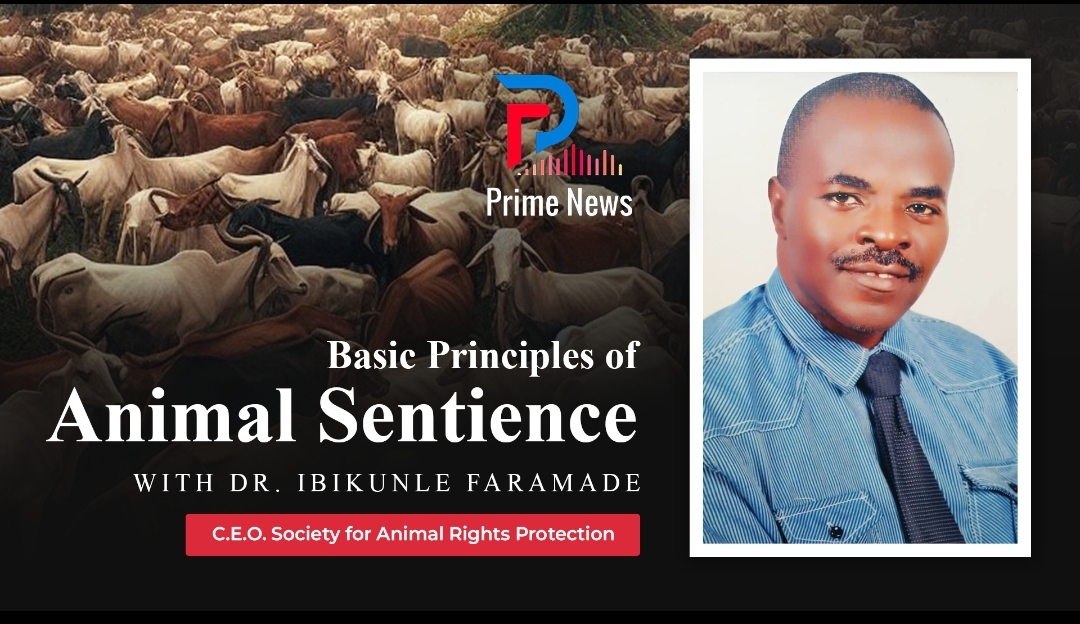By Dr Ibikunle Faramade
The abuse of animal welfare or cruelty to animals could be defined as the infliction, by omission or commission of suffering or harm by humans upon non-human animals. A person could be accused of cruelty to animals if he cruelly beats, kicks, maltreat, overrides, overdrives, overloads…etc.
Animal cruelty could be passive or active. It is passive when cruelty is a matter of negligence or in-action. This include inadequate provision of shelter to shield the animals from rain or excessive sun, inadequate provision of adequate food and water etc. Active cruelty involves infliction of injury directly on the animals such as pouring hot water on animals, hot iron branding, the use of sharp objects like machetes, knives etc.
Animal abuse has long been linked with other forms of antisocial behaviors and criminal violence. It is estimated that animal abusers are five times more likely to commit violent crimes against people than non-animal abusers. They are also four times likely to commit property crimes and three times more likely to have a record for drug or disorderly conduct offenses.
Why should Animal Cruelty or Animal Abuse be Taken Seriously?
- Animal abuse can identify individuals who are engaging in other criminal activities. Different acts of animal cruelty are linked to other crimes, e.g., crimes of violence against humans, drug or disorderly conduct offenses, property crimes etc. it is worthy of note that animal fighting, particularly, has been linked to gang, weapons, human trafficking, gambling and narcotic offenses.
- Animal abuse can expose family violence. Research has shown that if an animal is being abused in a family, it is likely that a child, partner or other resident is also being hurt or threatened.
- Investigation of animal neglect or cruelty could provide access to a troubled family. Animal abuse is the most frequently visible sign of family violence. Concerned neighbors are most likely to report suspected animal abuse than they are to report other forms of family violence. This could give opportunity to access homes, thereby granting a window to discover other deep seated troubles that may be affecting such homes.
- Animal cruelty serves as indicator that children pose a risk to themselves as well as others. Animal cruelty is an important form of physical aggression. Some researchers have also suggested that the most strategic intervention point is the preschool and early elementary school years. Increased rate of animal abuse has been observed not only among the youths, who bully, but also among youths who have been bullied. According to the United States Department of Education, the American Psychological Association, and the National Crime Prevention Council of the US, animal cruelty is a warning sign of youth at risk.
- Victims of both animal and human violence have shown to be more comfortable to talk about animal abuse. A woman who is afraid to admit her partners abusive behavior may feel less threatened reporting that he is cruel to animals. A neighbor of an abusive family is more likely to report animal abuse first. This helps to stimulate a dialogue which could eventually lead to the discovery of the perpetrators of human –directed violence.
The Federal Bureau of Investigation after comprehensive analysis of the lives of notorious killers for more than six decades suggested that many, if not most, had killed or tortured animals as children. Examples include the following: Serial killer Henry Lee Lucas killed at least 11 people between 1960 and 1983. “As a young teenager . . . Lucas reported having sex with . . . the animals whose throats [he and his half-brother] would cut open before performing bestiality. He often caught small animals and skinned them alive for pleasure.”
Albert DeSalvo, the “Boston Strangler” who killed 13 women between 1962 and 1964, trapped dogs and cats in orange crates and then released them to attack each other. Between 1964 and 1973, serial killer Edmund Kemper committed at least 8 murders. As a teen, he killed both grandparents and beheaded his own mother. “From a broken home, [Kemper] showed all the ‘early warning signs’ of violence to come…playing death games with his sister, beheading her dolls, and later cutting the family cat into pieces.”
David Berkowitz, the “Son of Sam” killer who killed six and wounded several others in New York City in the mid-1970s, poisoned his mother’s parakeet. Dennis Rader, the BTK killer (“Bind, Torture, Kill” was his signature on letters to the authorities), killed 10 in Kansas between 1974 and 1991. It’s reported that he used to hang stray animals as a child.
Jeffrey Dahmer, who raped, murdered, and dismembered 17 men and boys between the years 1978 and 1991, reportedly would kill and skin animals and then soak their bones and mount them on stakes in his backyard. Patrick Sherill, who in 1986 killed 14 coworkers at an Oklahoma post office and then shot himself, had a history of stealing local pets and tying them to a fence with baling wire.
In 1997 outside Jackson, Mississippi, Pearl High School student Luke Woodham stabbed his mother to death and then opened fire on classmates with a rifle, killing two and wounding seven others. Woodham had written of the torture and killing of his pet dog, calling it his “first kill.”
In May 1998, 15-year-old Kip Kinkel shot his parents to death before emptying three guns at his classmates in Thurston High School in Oregon, leaving one dead and 26 injured. Kip had often bragged to others at school about how he tortured animals.
The link between animal abuse and violent behavior goes beyond notorious violent crimes alone. A three-year, three-part study by the Massachusetts Society for the Prevention of Cruelty to Animals (MSPCA) and Northeastern University involved the identification of animal abusers (individuals who had been criminally charged with intentional physical harm to animals) and tracing their other criminal behavior. The criminal records of 153 individuals prosecuted by the MSPCA between 1975 and 1986 for intentional physical cruelty to animals were tracked for 20 years— 10 years before the abuse and 10 years after. Seventy percent of the people who committed violent crimes against animals also had criminal records for violent, property, drug, or disorder crimes. When compared to the control group (of identical age and gender and residing in the same neighborhoods as the offenders), the animal abusers were five times more likely to commit violent crimes against people, four times more likely to commit property crimes, and three times more likely to have a record for drug or disorderly conduct offenses. These and many more examples are great warnings that the issue of animal welfare abuses and cruelty to animals should not be treated with kid gloves in Nigeria. It is very certain that the structure for the investigation and prosecution of animal welfare and cruelty abuses are already on ground.
Apart from section 485 of the criminal code of 1990 which spelt out different offenses to which any animal welfare abuser could be liable, the Animal Disease Control Acts (2022) gave enormous prosecutorial powers to the police to investigate and prosecute all manners of animal welfare and animal rights abuses in Nigeria.
In conclusion, it is hereby recommended that the Force Animal Branch of the Nigeria Police should rev up their oversight functions in the area of enforcement of animal welfare laws. It is also important to state that the time is ripe for the creation of special units, including animal welfare investigation unit, under the Force Animal Branch in the 36 states of the Federation and the Federal Capital Territory.
Doing so, will make Nigeria to be positively referenced and buoy her image in the comity of Nations. This is because nations with good reputation for animal welfare have been shown to have corresponding reputation for human capital development, high quality of life, demonstrated by high life expectancy and other positive attributes of Human Development Indices.
Dr. Ibikunle Faramade is a veterinary pathologist and a lecturer at the Federal College of Animal Health & Production Technology, Apata. Ibadan. He’s the C.E.O of the Society for Animal Rights Protection, a non-profit and a non-governmental organization dedicated to the promotion of animal welfare, animal rights and prevention of cruelty to animals.
animalrightsprotection2020@gmail.com , +2348028305284




